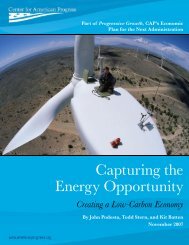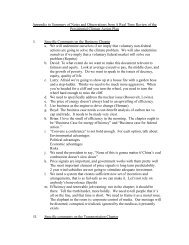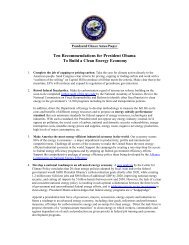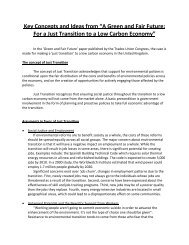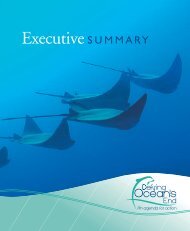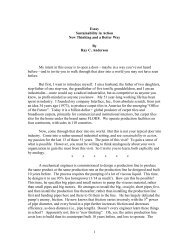PCAP - Presidential Climate Action Project
PCAP - Presidential Climate Action Project
PCAP - Presidential Climate Action Project
- No tags were found...
Create successful ePaper yourself
Turn your PDF publications into a flip-book with our unique Google optimized e-Paper software.
The OMB is an office in the EOP. The Director is the head of the OMB and is appointed by thePresident, by and with the advice and consent of the Senate. The Director administers the Office“under the direction of the President.” 286 Thus, the President’s authority is at its peak over anoffice such as OMB. 287Executive Orders. The President can establish, by executive directive, principles upon which tojustify expenditures, and direct agencies to use these principles to justify their budgetsubmissions or legislative proposals. For example, a common principle is to justify budgetproposals with a cost benefit analysis, and the analysis can include both quantitative andqualitative measures. E.O. 12893, Principles for Federal Infrastructure Investments (January 26,1994) exemplifies all of these parameters. The Order establishes four principles of federalinfrastructure investment: (a) systematic analysis of expected benefits and costs; (b) efficientmanagement; (c) private sector participation; and (d) encouragement of more effective state andlocal programs. It directs agencies to use these principles to justify major infrastructureinvestment and grant programs in their annual budget submissions to OMB. It also requiresagencies to employ these principles and supporting analyses when requesting OMB clearance forlegislative proposals that would authorize or reauthorize infrastructure programs.The systematic analysis of expected benefits and costs is defined by the Order as follows(emphasis added):Infrastructure investments shall be based on systematic analysis ofexpected benefits and costs, including both quantitative and qualitativemeasures, in accordance with the following:(1) Benefits and costs should be quantified and monetized to themaximum extent practicable. All types of benefits and costs, both marketand nonmarket, should be considered. To the extent that environmentaland other nonmarket benefits and costs can be quantified, they shall begiven the same weight as quantifiable market benefits and costs.(2) Benefits and costs should be measured and appropriately discountedover the full life cycle of each project. Such analysis will enable informedtradeoffs among capital outlays, operating and maintenance costs, andnonmonetary costs borne by the public.* * * * *(5) Analyses should consider not only quantifiable measures of benefitsand costs, but also qualitative measures reflecting values that are notreadily quantified.286 31 U.S.C. §§ 501, 502(a).287 Boundaries Report, Chapter VI(1), (2) and introductory paragraph.CEES 70 | P age




